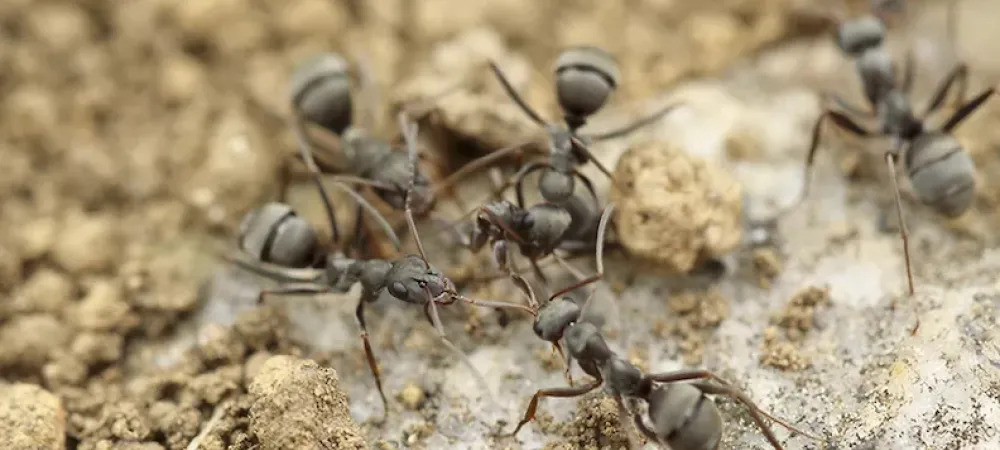How to Get Rid of Ants in the House

Ultimately getting rid of ants comes down to correctly identifying the species which you are afflicted with and determining the most effective method by which to treat them. There are many different home remedies, from using hand soap or glass cleaner to coffee grounds or Neem oil. Everybody has a different method which they swear by. Unfortunately, there are over 12,000 species of ants across the world, and what works for one could instead be a disaster for another. Here we want to try and provide you with potential methods of dealing with some of the most common house ants which you might find.
Getting Rid of Ants in Your Home
What not to do
The first thing to do about ants in your home is to understand what you shouldn’t do. Ants are an incredibly persistent pest, which is why they are the most common insect found on Earth and have developed a very efficient method of surviving in even the most hostile environments. Given the strong societal bonds ants have within the colony and their famous teamwork, unless you have a complete plan to deal with the issue you won’t be able to completely eliminate them.
The first instinct of most people is to spray, spray with bug killer, vinegar, or any other spray which they think will kill the ants. Indeed, initially, the spray will likely kill the ants. However, all this does is kill the worker ants. The colony will recognize that its workers are dying and will go into overdrive to produce new workers to ensure their survival. This process, known as budding, leads to new queens striking out and attempting to form new colonies, only exacerbating the problem. The more you spray, the more the ants try to form new colonies in different locations all-around your home.
What to do
As with most pest issues, the best way to deal with it is to prevent the infestation in the first place. The most important thing to do is keep their food sources to a minimum. Keep food well sealed and stored, any sweet spillages cleaned up right away, and especially clean up after any pet food.
However, if you’re here then that hasn’t worked. The DIY approach takes effort and persistence for a complete solution. Professional pest control services have the gear and expertise to deal with an infestation as fast a time as possible. In terms of home methods, the key is to find where the ants originate. If they are indoors, it’ll likely be a hole in grouting or sealant in a dark, damp place with access to food. Try behind the fridge, dishwasher, under the sink, places like that. Once located, any over-the-shelf pesticides can be effective, or homeopathic alternatives like Boric acid or baking soda.
Boric Acid can be effective because it takes time for it to work on the individual ant, allowing them time, if baited effectively, to bring the acid to the colony as food, eliminating all the queens and the workers before they can respond. A Boric acid, sugar, and water solution is the perfect concoction to attract the ants and then kill them. Be warned though, Boric acid can be harmful, so keep away from pets, children, and be sure to wear gloves when handling it.
Will Ants Go Away on Their Own?
The short answer is unlikely. If what you have is a true colony and not just a few stray ants, then it is likely that they have dug in and are here to stay. Eliminating food sources, as stated before, is the single most effective method of dealing with stray ants and smaller collections, but if they can continue to feed then the colony has no incentive to move on.
Be aware also that ant incidents do have natural peaks and troughs. In the spring and summer, you are much more likely to see ants, they enjoy the warming weather and it is much more conducive to their living. If you are seeing a large number of ants in the wintertime then you can be much safer in assuming that you have a real ant problem.
Types of House Ants
As said, with over 12,000 different species of ants it can be a chore just to discover which ant species you are dealing with. Thankfully, in North America, we can at least narrow down the nuisance ants to a few specific kinds. Here we will address a few of the most common species of ants.
Odorous House Ants
- Appearance: Brown or Black body color, smooth hairless body, 1/8" - 3/16” in size.
- Habitat: Like to nest in wall or floor voids in homes, close to warmth and moisture.
- Diet: Prefer sweets (sugar, syrup, honey) and Meats.
- Unique identifier: Pungent smell of rotten coconut when crushed.
What attracts odorous house ants?
Odorous House Ants are attracted, like most, by food and shelter. They prefer to build their homes in kitchens or pantries, in the walls or floors, such that they are close to plentiful food sources. Odorous ants are able to bite but it isn’t common and the bites shouldn’t cause too much discomfort for adults. They are very persistent and their numbers can grow quickly if left unchecked. Given the voracious appetite of odorous ants, the best home method is poisoned bait and limiting indoor-outdoor cross-contamination.
Pharaoh Ants
- Appearance: Yellowish-brown color, red/black markings on abdomen, >1/16” (tiny)
- Habitat: Love artificial heating sources in the winter, baseboards and cabinet voids.
- Diet: Any food, but especially sweets
- Unique identifier: large, 12 segmented antenna with bent club tip.
What attracts pharaoh ants?
In the cold Pharaoh ants seek out heat sources, the backs of kitchen electronics or artificial heaters in general. Pharaoh ants are strongly susceptible to budding, so do not attempt to handle the first ant that you see, instead seek professional help or find the nest. Populations of this ant can grow incredibly quickly, so you need to get a handle on any suspected infestation fast. Again, due to the likelihood of budding, effective poisoned bait is your most reliable removal option.
Carpenter Ants
- Appearance: Red/Black, all black, all brown. Rounded thorax. 1/4" - 1/2" (large)
- Habitat: Moisture is key, decaying wood, untreated wooden walls/floors
- Diet: Sweets and Meats, also other insects
- Unique identifier: Very large ant, large mandibles
What attracts carpenter ants?
Carpenter ants are one of the largest ant species in the United States, and they love to build their nests in old wood. Similar to termites in their love for old wood, instead of eating the wood they will hollow out wood and build their nest where the wood has been removed. Their love for all things wood is what gives them their names. It has been commonly observed that carpenter ants can use overhanging branches or leaves to enter into houses, so keep an eye on the state of your trees.
Carpenter ants can cause serious structural damage if left unchecked, so call a professional as soon as you notice the infestation. Signs of infestation include worker trails, wooden debris piles, a rustling sound in the home’s wood. Less prone to budding, unless swarming (this will involve flying ants so should be eminently noticeable). Boric acid into the nest is effective, along with baited food.
